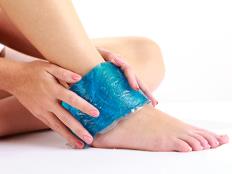6. Iliotibial Band Syndrome (ITBS)
The iliotibial (IT) band lies along the outside of the thigh from the hip to the knee. When you run, your knee flexes and extends, which causes the IT band to rub on the side of the femur. This can cause irritation if you take up your mileage too quickly, especially if you're doing a lot of track work or downhill running. ITBS makes up 12 percent of all running injuries; 14 percent of poll respondents experienced this in the past year.
WHO'S AT RISK?
Runners who develop ITBS may overpronate, have a leg-length discrepancy, or suffer from weak hip abductor and gluteal muscles.
"If your hip motion is not well controlled, then your IT band gets stretched with your running stride, and that can irritate it," Heiderscheit says.
CAN YOU RUN THROUGH IT?
ITBS is known as a stubborn, nagging injury. Take a rest day or two and back off your mileage for a week, and you could avoid a full-blown flare-up, Dr. Price says. If you ignore the first symptoms and continue training at your usual mileage and intensity, you can exacerbate it.
REHAB IT
Strengthen the hip abductors with lateral side steps, side leg lifts, and one-legged squats. Use a foam roller before and after you run: Rest the outside of your thigh on top of the roller, and roll your IT band from your knee to your hip. Hiking and bicycling can aggravate ITBS. Instead, swim, pool-run, and use an elliptical trainer.
PREVENT A RELAPSE
Continue exercises and foam-rolling. Change directions every few laps while on a track, and limit how often you do hilly routes, Heiderscheit says. IT band issues often get better if you can learn to shorten your stride so that your weight centers on the front of the heel or the midfoot as you land.
"A five to 10 percent difference in your stride length can make a huge difference," Heiderscheit says.
ELITE TREATMENT
Two-time Olympian (5000 meters) Bolota Asmerom, of Oakland, Calif., dealt with ITBS when he took up his training to 70 miles a week in 1999.
"I got relief through massage, strength, and flexibility work," he says. "I've stayed injury-free since then because I take care of every ache with massage and ice. I also try to avoid doing too much track running."
Thigh Anxiety: How to Proceed
If you experience pain on the outside of the knee that radiates up and down your leg when just walking down a hill or stairs.
When twinges on the outside of the knee appear within 10 minutes of beginning a run, but disappear during a walk break.
When your outer knee and thigh are completely pain-free—even after running a particularly hilly route or circling a track.
- 7
- of
- 8
Get ACTIVE on the Go


Couch to 5K®
The best way to get new runners off the couch and across the finish line of their first 5K.
Available for iOS | Android







Discuss This Article